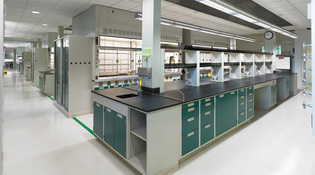 loading
loading
Deal of the century Christopher GardnerBayer left behind hundreds of thousands of square feet of high-quality laboratory space, most of which is yet to be occupied. View full imageThe eerie emptiness notwithstanding, there is plenty happening on the West Campus now, including a lot of unpacking. Four researchers have opened their laboratories there this year. Three of them are new recruits to Yale; the university has been using the site to lure researchers from around the world, promising not only modern labs but also a chance to get in on the start of a new interdisciplinary approach to science.
The word "interdisciplinary" is on the lips of academics everywhere these days, not least at Yale. University administrators are constantly talking about "breaking down departmental barriers" to allow "cross-pollination" among researchers in different disciplines. But long-established departments and their facilities aren’t easily reconfigured for cross-pollination. What the West Campus offers is a chance to start from scratch, with programs designed around new areas of inquiry rather than existing disciplines. One major part of this strategy will be five new scientific "institutes," each with nine or ten research labs working on related interdisciplinary problems: cancer biology, chemical biology, biodesign, systems biology, and microbial diversity. (To read about three scientists now working at the West Campus, see "The Pioneers.”) How interdisciplinary are these institutes? The advisory committee to the Microbial Diversity Institute has representatives from ten different departments on Science Hill and at the medical school, from geology and geophysics to public health. "It’s remarkable the fireworks that go on" at meetings of the advisory committees, says Donoghue, who attends them all. "This is the first time these people have sat down to have a substantive discussion with each other. Every one of those meetings comes out with something new.” Another innovation enabled by the West Campus lab space is the science centers Yale calls "cores.” You could think of a core as an extremely high-tech Kinko’s: each performs an essential service for researchers all over Yale. Three are now open for business. The Center for Genome Analysis has a battery of state-of-the-art DNA sequencing machines—any one of them can analyze the entire human genome in a week—to provide genetic information for experiments in progress. The Center for High Throughput Cell Biology uses an automated process to disable single human genes in cells, so that researchers can try to deduce the gene’s function. And the Small Molecule Discovery Center helps scientists test the effects of small molecules on cell function. The West Campus labs are filling more slowly than Yale originally projected, in part because of the economy’s effect on Yale’s endowment: overall, the university has cut budgets 10 percent since the 2008 economic collapse. But Donoghue says recruitment takes time anyway, especially when the post is one that Yale hopes to fill with a star academic. "The budget is not the rate-limiting step. It’s finding the right leadership," he says. "These searches can take years.”
As the first of those scientists get their labs up and running, another building is already well populated—with mounted animal heads, kayaks, skeletons, and nineteenth-century scientific instruments. Down the hall in the same building, a set of Roman mosaics is being painstakingly removed from its concrete backing. Across the hall from the mosaics, the parlor of an eighteenth-century Connecticut house has been rebuilt on an enormous warehouse floor. Yale’s museums have set up shop in Building A21 (Yale has, for now, retained Bayer’s unromantic nomenclature), where they have the kind of space they only dreamed about in New Haven. The museums can put only small portions of their collections on display in central campus, so uncluttered, accessible storage space is a great boon to curators, faculty, students, and researchers who want to have a look at the collections. The Peabody, which has been the most pressed for quality storage, moved a large portion of its holdings out of its basements and into the West Campus in 2008. The Center for British Art and the University Art Gallery will be moving parts of their collections to A21 as well. The art gallery is also using the building for conservation projects that, like the mosaics and the parlor, need a lot of room. And soon, the museums and the Yale University Library will be collaborating on a permanent conservation laboratory, where they can share equipment and expertise in the care of their artifacts—an arrangement the university compares to the science cores. Yale has won a grant from the Mellon Foundation to hire a research scientist who will work full-time in the new lab. Another core will allow the museums and libraries to share equipment for making digital images of their holdings.
|
|